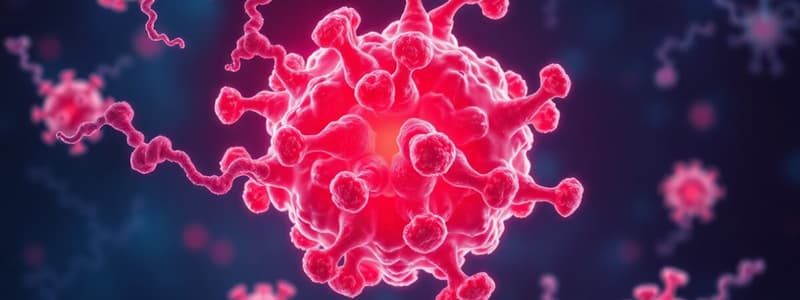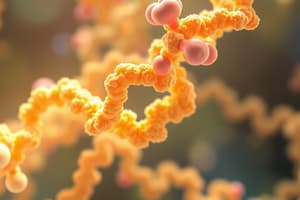Podcast
Questions and Answers
Which statement is incorrect regarding interferons?
Which statement is incorrect regarding interferons?
- Interferons are solely produced in the laboratory without any natural occurrence. (correct)
- All types of interferons play a role in fighting cancer.
- Interferons communicate between cells to trigger immune responses.
- Interferon alpha is approved for treating chronic hepatitis C.
Which of the following statements about recombinant interferon is false?
Which of the following statements about recombinant interferon is false?
- Interferon alfa-2a is produced using genetically engineered Escherichia coli.
- Recombinant interferon alfa-2a is derived from human DNA.
- Recombinant DNA technology allows for the production of therapeutic proteins.
- Recombinant interferon is isolated from the pathogens themselves. (correct)
Which of the following is an incorrect application of interferon therapies?
Which of the following is an incorrect application of interferon therapies?
- Interferon alfa is indicated for chronic hepatitis C.
- Interferon alpha is used to treat chronic hepatitis B.
- Interferon beta has no known antiviral effect. (correct)
- Interferons are utilized in cancer therapies.
Which of the following statements is incorrect about the types of interferons?
Which of the following statements is incorrect about the types of interferons?
Which of the following statements regarding the action of interferons is incorrect?
Which of the following statements regarding the action of interferons is incorrect?
Which of the following statements about hydrolytic deamidation is correct?
Which of the following statements about hydrolytic deamidation is correct?
Which of the following correctly describes the oxidation process of amino acids?
Which of the following correctly describes the oxidation process of amino acids?
Which statement about racemization is incorrect?
Which statement about racemization is incorrect?
Which of the following processes does not involve amino acid modification?
Which of the following processes does not involve amino acid modification?
Which of the following statements about the effects of hydrolytic deamidation and oxidation is correct?
Which of the following statements about the effects of hydrolytic deamidation and oxidation is correct?
Which of the following amino acids would be most susceptible to oxidative changes?
Which of the following amino acids would be most susceptible to oxidative changes?
Which process is least likely to occur during the aging of recombinant therapeutic proteins?
Which process is least likely to occur during the aging of recombinant therapeutic proteins?
In the context of protein modifications, which statement is correct?
In the context of protein modifications, which statement is correct?
Interferon-beta is primarily indicated for the treatment of which condition?
Interferon-beta is primarily indicated for the treatment of which condition?
Which of the following statements regarding IFN-γ is correct?
Which of the following statements regarding IFN-γ is correct?
What is a consequence of chemical instability in recombinant therapeutic proteins?
What is a consequence of chemical instability in recombinant therapeutic proteins?
Which statement about physical instability in proteins is inaccurate?
Which statement about physical instability in proteins is inaccurate?
Among the following, which peptide linkage is considered the least stable?
Among the following, which peptide linkage is considered the least stable?
The primary issue that arises from chemical instability in recombinant proteins is:
The primary issue that arises from chemical instability in recombinant proteins is:
Which of the following conditions is NOT treated by recombinant interferons?
Which of the following conditions is NOT treated by recombinant interferons?
Which statement about chronic granulomatous disease is incorrect?
Which statement about chronic granulomatous disease is incorrect?
What characterizes early symptoms of multiple sclerosis?
What characterizes early symptoms of multiple sclerosis?
Which factor is NOT associated with the instability of recombinant proteins?
Which factor is NOT associated with the instability of recombinant proteins?
Which of the following accurately describes a mechanism that contributes to the instability of recombinant proteins?
Which of the following accurately describes a mechanism that contributes to the instability of recombinant proteins?
Which statement regarding erythropoietin (EPO) levels is incorrect?
Which statement regarding erythropoietin (EPO) levels is incorrect?
Which of the following influences the stability of recombinant proteins?
Which of the following influences the stability of recombinant proteins?
Which factor does NOT contribute to the instability of erythropoietin?
Which factor does NOT contribute to the instability of erythropoietin?
Which option is NOT a typical symptom associated with anemia?
Which option is NOT a typical symptom associated with anemia?
Which factor contributes to the denaturation of recombinant proteins?
Which factor contributes to the denaturation of recombinant proteins?
Which statement about the relationship between anemia and underlying conditions is incorrect?
Which statement about the relationship between anemia and underlying conditions is incorrect?
Which consequence of low erythropoietin levels is correctly stated?
Which consequence of low erythropoietin levels is correctly stated?
Which of these does NOT typically affect recombinant protein production in bacteria?
Which of these does NOT typically affect recombinant protein production in bacteria?
Which process is least likely to cause instability in recombinant proteins?
Which process is least likely to cause instability in recombinant proteins?
Which statement regarding erythropoiesis-stimulating agents (ESAs) is correct?
Which statement regarding erythropoiesis-stimulating agents (ESAs) is correct?
Which of the following correctly describes the function of interferons?
Which of the following correctly describes the function of interferons?
Which statement about recombinant production techniques is incorrect?
Which statement about recombinant production techniques is incorrect?
Which of the following statements about FDA-approved uses of recombinant proteins is correct?
Which of the following statements about FDA-approved uses of recombinant proteins is correct?
Which statement about anemia and erythropoietin (EPO) is incorrect?
Which statement about anemia and erythropoietin (EPO) is incorrect?
Which of the following statements regarding the clinical applications of interferons is correct?
Which of the following statements regarding the clinical applications of interferons is correct?
Which statement about the role of genetically engineered cells in protein production is incorrect?
Which statement about the role of genetically engineered cells in protein production is incorrect?
Which of the following statements about recombinant protein instability is correct?
Which of the following statements about recombinant protein instability is correct?
Which statement regarding the immune response and interferons is incorrect?
Which statement regarding the immune response and interferons is incorrect?
Which of the following about erythropoietin (EPO) is correct?
Which of the following about erythropoietin (EPO) is correct?
Flashcards
Deamidation of Asparagine/Glutamine
Deamidation of Asparagine/Glutamine
Asparagine and Glutamine can change to Aspartate and Glutamate.
Oxidation in Proteins
Oxidation in Proteins
Sulfur-containing amino acids (Methionine and Cysteine) can oxidize.
Racemization
Racemization
Amino acids change their 'handedness' (L to D).
Amino Acid Susceptibility
Amino Acid Susceptibility
Signup and view all the flashcards
Protein Degradation Types
Protein Degradation Types
Signup and view all the flashcards
Methionine Oxidation
Methionine Oxidation
Signup and view all the flashcards
Cysteine Oxidation
Cysteine Oxidation
Signup and view all the flashcards
Effect of Racemization
Effect of Racemization
Signup and view all the flashcards
Interferon
Interferon
Signup and view all the flashcards
Recombinant interferon
Recombinant interferon
Signup and view all the flashcards
Interferon alpha
Interferon alpha
Signup and view all the flashcards
Recombinant DNA
Recombinant DNA
Signup and view all the flashcards
Therapeutic proteins
Therapeutic proteins
Signup and view all the flashcards
Interferon-beta's use
Interferon-beta's use
Signup and view all the flashcards
IFN-γ's use
IFN-γ's use
Signup and view all the flashcards
Chemical Instability (proteins)
Chemical Instability (proteins)
Signup and view all the flashcards
Physical Instability(proteins)
Physical Instability(proteins)
Signup and view all the flashcards
Hydrolysis (proteins)
Hydrolysis (proteins)
Signup and view all the flashcards
Least stable peptide linkage
Least stable peptide linkage
Signup and view all the flashcards
Multiple Sclerosis (MS)
Multiple Sclerosis (MS)
Signup and view all the flashcards
Chronic Granulomatous Disease
Chronic Granulomatous Disease
Signup and view all the flashcards
Recombinant proteins
Recombinant proteins
Signup and view all the flashcards
Biologic activity loss
Biologic activity loss
Signup and view all the flashcards
Instability of recombinant proteins
Instability of recombinant proteins
Signup and view all the flashcards
Hydrolysis
Hydrolysis
Signup and view all the flashcards
Oxidation
Oxidation
Signup and view all the flashcards
Denaturation
Denaturation
Signup and view all the flashcards
Anemia
Anemia
Signup and view all the flashcards
Erythropoietin (EPO)
Erythropoietin (EPO)
Signup and view all the flashcards
Glycoprotein
Glycoprotein
Signup and view all the flashcards
Red blood cells
Red blood cells
Signup and view all the flashcards
Hemoglobin
Hemoglobin
Signup and view all the flashcards
Erythropoiesis
Erythropoiesis
Signup and view all the flashcards
Erythropoiesis-Stimulating Agents (ESAs)
Erythropoiesis-Stimulating Agents (ESAs)
Signup and view all the flashcards
Recombinant Production
Recombinant Production
Signup and view all the flashcards
Escherichia coli (E. coli)
Escherichia coli (E. coli)
Signup and view all the flashcards
CHO cells
CHO cells
Signup and view all the flashcards
Clinical Applications of Recombinant Proteins
Clinical Applications of Recombinant Proteins
Signup and view all the flashcards
Recombinant Protein Instability
Recombinant Protein Instability
Signup and view all the flashcards
Study Notes
Biochemistry and Biotechnology Fundamentals - Recombinant Therapeutic Proteins II
- The course covers recombinant therapeutic proteins, focusing on erythropoietin (EPO) and interferons.
- Anemia is a condition where the body lacks sufficient healthy red blood cells or haemoglobin to transport oxygen.
- Erythropoietin (EPO) is a hormone naturally produced by the kidneys to stimulate red blood cell production.
- Erythropoiesis-stimulating agents (ESAs) are synthetic EPOs made via recombinant DNA technology.
- ESAs are used to treat anemia, particularly in chronic kidney disease and chemotherapy-induced cases.
- Interferons are naturally occurring proteins produced by host cells in response to pathogens. They stimulate protective immune responses against infections.
- Interferons are used as therapeutic agents, playing a role in treating various diseases, including viral infections, multiple sclerosis, and certain cancers.
- Recombinant DNA technology is employed in producing therapeutic proteins. The technology inserts the desired gene into a host organism to produce the protein.
- Genetically modified cells, such as Escherichia coli and Chinese hamster ovary (CHO) cells, are commonly used for large-scale protein production.
- Important factors in protein stability include chemical instability (bond formation or cleavage modifying the protein) and physical instability (changes in secondary and higher-order protein structure).
- Chemical instability can result from hydrolysis of specific peptide bonds (e.g., Asp-Pro) and hydrolytic deamidation (e.g., asparagine and glutamine).
- Oxidation can occur at Met and Cys side chains leading to the formation of sulfoxides or sulfones.
- Racemization involves inverting the configuration at asymmetric centers in the protein, creating mixtures of L and D configurations.
- Physical instability often leads to denaturation and self-aggregation, usually triggered by elevated temperatures, drastic pH changes, or addition of organic solvents.
Studying That Suits You
Use AI to generate personalized quizzes and flashcards to suit your learning preferences.




